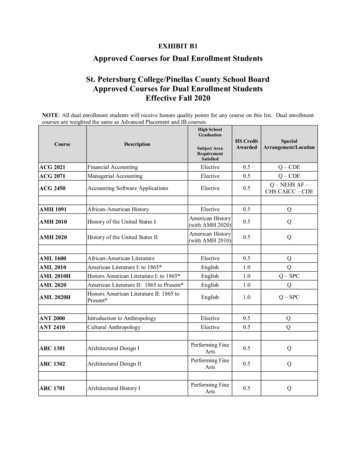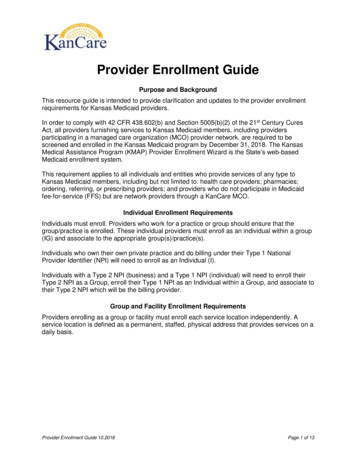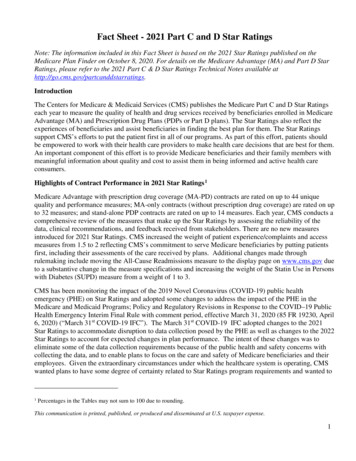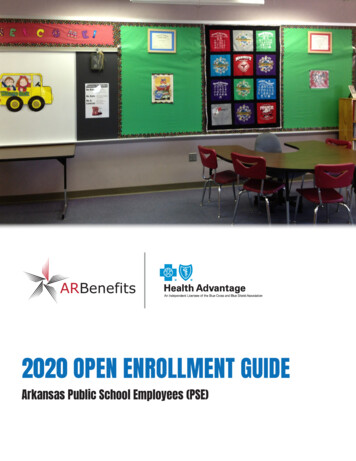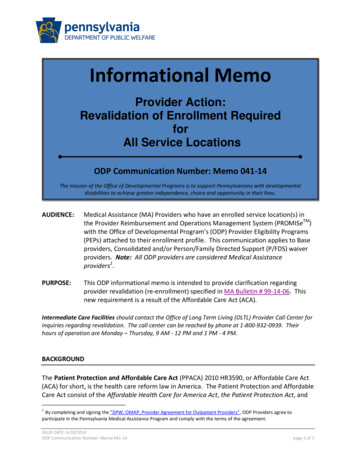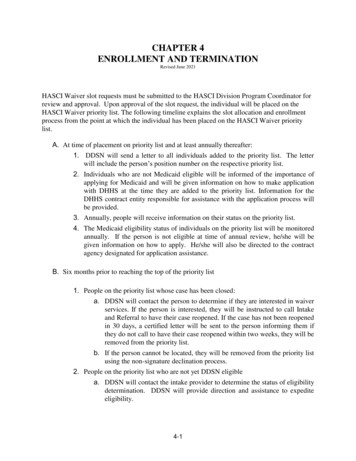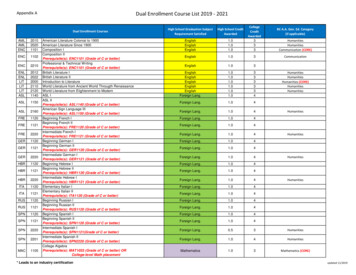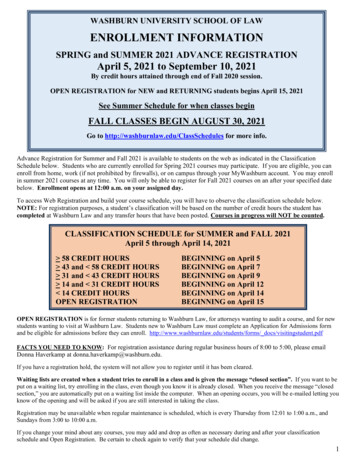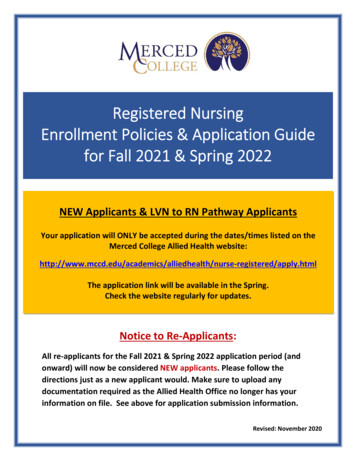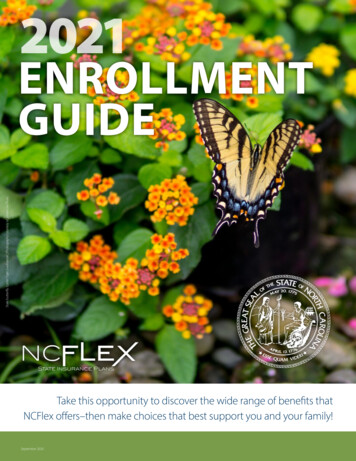
Transcription
2021State butterfly: Easter Tiger Swallowtail Photography courtesy of Jordan via FlickrENROLLMENTGUIDETake this opportunity to discover the wide range of benefits thatNCFlex offers–then make choices that best support you and your family!September 2020
Welcome to NCFlex Enrollment!State blue berry: Blueberry Photography courtesy of Twinkle Lettkeman via FlickrNCFlex gives you access to a variety of benefits and resources to helpyou take care of your physical, emotional and financial health. It’s upto you to choose the benefits that best meet your needs. Take actionto make the most of all that NCFlex offers, including:6 Flexible Spending Accounts Health Care Flexible Spending Account (HCFSA) Dependent Day Care Flexible Spending Account (DDCFSA)9 Supplemental Medical Accident Plan Cancer and Specified Disease Critical Illness15 Dental17 Vision19 Financial & Survivor Group Term Life Core Accidental Death & Dismemberment (AD&D)About This GuideThis guide describes benefitsoffered through NCFlex. Inthe event of any discrepancybetween what is written hereand what is written in theplan document and insurancecertificates, the plan documentand insurance certificates willgovern. Changes in the tax lawsor other requirements mightcause changes in the plan.The State reserves the right toamend or terminate the planor any benefits under the planat any time. This guide is onlya summary of the benefit plan.You may review and/or obtaina copy of the Certificate ofCoverage by visiting our websiteat ncflex.org. Voluntary Accidental Death & Dismemberment (AD&D) Disability33 TRICARE Supplement PlanQuestions?Contact your local HealthBenefits Representative(HBR) or Human ResourcesDepartment, ncflex@nc.gov,or you can contact theindividual benefit vendorson the back of this guide.2
Enrolling for BenefitsState flower: Dogwood Photography courtesy of Alvaro Reguly via FlickrWhen You Can EnrollAs a New Hire orNewly Benefits-Eligible EmployeeAs a Current EmployeeDuring Annual EnrollmentAs a Current EmployeeIf You Have a Qualifying Life EventBenefits are effective on the firstof the month following your dateof hire or eligibility date.*Benefits are effective January 1of the new plan year (2021),unless EOI is required.Benefits are effective the first of themonth following your life event.*You have 30 days from your date ofhire to enroll in benefits. Your benefitelections are effective on the first day ofthe month following your date of hire.Annual enrollment is your once-a-yearopportunity to review and select yourbenefits for the coming year, add orcancel dependent coverage, and enrollin the Flexible Spending Accounts.Annual Enrollment for 2021 will beOctober 15 – October 31, 2020.If you don’t enroll within 30 days, youwill not have any NCFlex benefits for theremainder of the plan year. Your nextchance to enroll will be next fall duringAnnual Enrollment for the followingplan year, or when you experience aqualifying life event that would allowyou to add or drop a dependent—likegetting married or divorced.If you do not enroll during theannual enrollment period, yourcurrent elections will roll over, exceptfor any flexible spending accountelections (Health Care FlexibleSpending Account or DependentDay Care Flexible Spending Account),which must be elected each year.You can enroll or make changes toyour benefit elections during theyear if you have a qualifying life event(see list below). You must enroll/make changes within 30 days of thequalifying event.Qualifying life events include, butare not limited to: Marriage Divorce or legal separation Birth, foster, or adoption (orplacement of adoption) of a child Death of a covered dependent Change in your spouse’semployment, impacting his/herbenefits eligibility Your dependent turns age 26Any change you make in coveragemust be consistent with your statuschange.*For the Disability plan, coverage is effective on the first day of the month following your enrollment in the plan.3
How to EnrollYou can enroll in NCFlex benefits in one of two ways:Online at ncflex.orgGo online to ncflex.org and click the Enroll Nowbutton.To log in: Select your work location from the list on theleft side of the screen; or Enter your user name and password. If you’veforgotten your user name or password, clickCan’t Access Your Account?.The enrollment system will walk you throughthe steps to enroll.Call 1-855-859-0966Call the eligibility and enrollment call center at1-855-859-0966, Monday – Friday, 8 a.m. – 5 p.m., ET.Call center hours will be extended during annualenrollment until 10 p.m. and will also include someweekend hours.NCFlex Pre-TaxAdvantageYour costs or contributions for thefollowing NCFlex benefits are madeon a pre-tax basis. Pre-tax benefitslet you pay for coverage with dollarsfrom your pay before taxes have beendeducted, which results in tax savingsfor you. Flexible Spending Accounts: HealthCare and Dependent Day Care Accident Plan Cancer and Specified Disease Critical Illness Dental Vision Group Term Life (for employeeonly premium) Voluntary Accidental Death& Dismemberment Voluntary Disability Plan TRICARE Supplement PlanYou pay for the Group Term Lifepremium for your dependents on apost-tax basis. Post-tax benefits letyou pay for coverage on a post-taxbasis using dollars from your pay aftertaxes have been calculated.Successful Enrollment TipsWhen you log in to the enrollment system, be sure to: Enter or update your contact information (phone number, email address) and be sureyour mailing address is correct (if not, enter your current information in yourHR/payroll system). We’ll use this information to communicate with you aboutyour benefits. Enter or update your dependent information, including date of birth and SocialSecurity number, for each dependent you want to enroll. Review, add and update beneficiaries on your Term Life, AD&D, Critical Illness andCancer plans, as needed. Print a confirmation statement after you have elected your benefits so you’ll havea record of your choices.Photography courtesy of bobbistraveling via Flickr4
EligibilityState reptile: Eastern Box Turtle Photography courtesy of Jamie via FlickrYouYou may enroll in any or all of the NCFlex benefits if you work for a state agency,university, select community college, or select charter school for 20 hoursor more per week in a permanent, probationary, or time-limited position.*If you have questions about your eligibility, contact your Health BenefitsRepresentative (HBR).*Applies to all benefits except NCFlex Disability plan. To be eligible for the disability plan, you mustwork 30 hours or more per week. Employees of The University of North Carolina and any constituentinstitution are not eligible for NCFlex Disability plan. For more information, go to ncflex.org and select“Disability.”Your DependentsYou Needto Know. You must be enrolled in a planfor your eligible dependent(s) toparticipate. You may not be covered as bothan employee and a dependentand children may not be duallyenrolled. You should consult with your taxadvisor if you have questions asto whether someone qualifies asyour income tax dependent.Your eligible dependents include: Your legally married spouse. Your children, including natural children, stepchildren, foster children oradopted children, until the end of the month in which the child turns age26. For the TRICARE Supplement, eligibility is up to age 21, or up to age 23 ifenrolled full-time in a school of higher learning. Dependents do not have to beenrolled on your health planin order to be enrolled on yourNCFlex plan(s). Your children of any age, including natural children, stepchildren, fosterchildren or adopted children, who are unable to make a living because of amental or physical handicap as long as the handicap developed before yourchild’s 26th birthday and your child was covered by the NCFlex plan for whichyou want to continue coverage prior to turning 26.Benefit Tip!If you plan to enroll dependents,allow yourself enough time to gatherany required documentation, such asdependents‘ Social Security numbersand dates of birth.5
Flexible SpendingAccountsState Christmas tree: Fraser Fir Photography courtesy of Soil Science via FlickrFlexible Spending Accounts (FSAs) help you save money on taxes by paying for eligible out-of-pockethealthcare and dependent care expenses with pre-tax dollars. You never pay taxes on the dollars you setaside in an FSA, which helps you save money. You must enroll in these accounts each year.You can enroll in one or both accounts: Health Care Flexible Spending Account (HCFSA) Dependent Day Care Flexible Spending Account (DDCFSA)Health Care Flexible Spending AccountFor the 2021 plan year, expenses must be incurredJanuary 1 through December 31, 2021, to be eligible forreimbursement. You have until March 31, 2022, to submitclaims for reimbursement. You can rollover up to 550 ofunused account balances into the next plan year, as longas you have a minimum balance of at least 25. Any fundsexceeding this amount will be forfeited.You can contribute from 120 to 2,750 each plan year.If your spouse is a state employee, he or she also cancontribute up to 2,750 each plan year. The full amount youelect to contribute to your Health Care FSA is available inyour account on the first day of the plan year or the first dayyour benefits become effective. Your contributions will bededucted on a pre-tax basis from your paycheck evenly overthe calendar year.You can go to ncflex.padmin.com to submit claimselectronically, check your account balance and more.Eligible expenses include:Your or your dependent’s (dependent does not have tobe covered on your medical plan) out-of-pocket costsfor doctor visit copays, prescription drugs, prescriptioneyeglasses, dental copays and deductibles, braces, contacts,hearing aids, qualifying every day health products, overthe-counter medications, menstrual items, and much more.For more details on qualifying expenses, go to ncflex.organd click on Flexible Spending Accounts.Benefit Tip!Estimate your expenses carefully so you won’t contributemore money to your Health Care FSA than you can spend inthe year. You are allowed to roll over up to 550 left in youraccount at the end of the year (December 31), but if youthink you will have leftover funds that exceed this amount,find ways to spend the money on eligible health care itemsyou need, such as a pair of glasses, first aid kits, or schedulea year-end dental appointment.Ineligible expenses include: Medical, dental and otherpremiums, vitamins, and supplements (unless prescribed bya doctor), cosmetic procedures including dental proceduresto whiten teeth, weight loss programs, unless prescribed by adoctor to alleviate a diagnosed medical condition or obesity.6
Dependent Day Care Flexible Spending Account (DDCFSA)The DDCFSA offers you a tax-free way to pay yourself backfor eligible dependent care expenses throughout the year.You can contribute between 120 and 5,000 each planyear to the DDCFSA to pay for dependent daycare andelder care expenses on a pre-tax basis if both you and yourspouse work, your spouse goes to school full-time or yourspouse isn’t able to care for himself or herself. The IRS sets themaximum contribution, which is 5,000 per family, per year.her support from you (e.g., your disabled elderly parent), whois physically or mentally incapable of caring for himself orherself and has the same principal place of residence as youfor more than one-half of the year.For more information on qualifying dependents andexpenses, go to ncflex.org and click on Flexible SpendingAccounts, or see IRS Publication 503.For the 2021 plan year, expenses must be incurred January1, 2021, through March 15, 2022, to be eligible forreimbursement. You have until March 31, 2022, to submitclaims for reimbursement. Any unused funds will be forfeited.Eligible expenses include: Daycare, summer day camp,after school programs, and preschool expenses for childrenunder age 13 or disabled dependents of any age. Sleep-awayor overnight camps are not covered. You may also use thisaccount to pay for adult day care services for a spouse orother dependent who receives more than one-half of his orYou can go to ncflex.padmin.com to submit claimselectronically, check your account balance and more.How Flexible Spending Accounts Save You MoneyExample of Annual Tax Savings*Without an FSAWith an FSAAnnual Pay 40,000 40,000Pre-tax Money Deposited into FSA- 0- 2,500Remaining Taxable Annual Pay 40,000 37,500Minus Federal and Social Security Taxes- 12,000- 11,250Take-home Pay Spent on Qualified Expenses- 2,500- 0Take-home Pay 25,500 26,250*Assumes annual tax rate of 30%.That’s a 750 increase in take-home paywith a Flexible Spending Account.7
Paying for ExpensesFiling ClaimsWhen you enroll in the HCFSA or DDCFSA, you willautomatically receive the NCFlex Convenience Card to helpyou pay for expenses. This card will be active for three years,as long as you remain enrolled in the account(s). A new cardwill be automatically mailed to you once this card expires.To file claims or to check your account balance at any time,log into your account at ncflex.padmin.com (from yourcomputer or mobile device) or call the number on your card.You can also register online to receive notifications via textmessage.HCFSAIf you do not use your card to pay for expenses, you can fileclaims for reimbursement online or by fax or mail.Your entire annual contribution amount is available onyour card on January 1, or the date your account becomeseffective, to pay for eligible expenses.DDCFSAMobile App Now AvailableThe money available on your card to pay for DDCFSAexpenses is equal to the amount you have actuallycontributed to your account (via payroll deductions).You can access your account anytime,anywhere by downloading the P&A Groupapp through the App Store or Google Play.Keep YourReceipts!Shop for EligibleExpenses Onlineat the FSA Store!The IRS requires thatALL claims be verified.Your NCFlex convenience card can auto-approvemost FSA-eligible health care items purchased atmany of your local pharmacies, discount stores andgrocery stores. The NCFlex convenience card alsocan auto-approve dependent care expenses at selectdaycare providers that have a valid merchant categorycode. However, if an item is not auto-approved, youmay receive a request to submit receipts or additionaldocumentation for verification. If you do not submitrequested receipts/documentation within 40 days ofthe transaction date, your card will be turned off (orblocked) automatically.You’ll experience convenience and savings whenyou shop at the FSA Store, a one-stop-shop thatoffers significant discounts on thousands ofpre-approved eligible FSA products. You canuse your NCFlex Convenience Card when youcheckout. Visit ncflex.padmin.com to accessthe FSA Store today.For More InformationFor more information about the FSAs, go to ncflex.org, select FlexibleSpending Accounts, then click Claim Forms, Plan Information, FAQs and More.8
AccidentState mammal: Gray Squirrel Photography courtesy of Michael Bamford via FlickrNCFlex offers an Accident Plan that pays you cash benefits for specific injuries and events resulting froma covered accident that occurs on or after your coverage effective date. You can use this money howeveryou like; for example, deductibles, other out-of-pocket medical costs, child care, housecleaning, groceriesor utilities. Benefits are paid directly to you and pay in addition to any other insurance you may have.Accident Monthly CostsSummary of BenefitsAll employees pay the same rate, no matter their age.The following list is a summary of the benefits providedby the Accident Plan. For a complete description of theavailable benefits, exclusions and limitations, see thecertificate of insurance and any riders, which are available atncflex.org.Coverage LevelCostEmployee Only 6.94Employee and Spouse 11.50Employee and Child(ren) 13.64Employee and Family 18.20The Accident Plan also provides a Sports Accident Benefit.If an accident occurs while participating in an organizedsporting activity as defined in the plan certificate, theAccident Hospital Care, Accident Care, or Common Injuriesbenefit will be increased by 25% to a maximum additionalbenefit of 1,000. If your spouse and/or children are/iscovered under the Accident Plan, their coverage includesthis benefit.EventAccident CareInitial doctor visitEmergency room treatmentGround ambulanceFollow-up doctor treatmentMedical equipmentPhysical or occupational therapyup to 10 per accidentSpeech therapy up to 6 per accidentProsthetic deviceMajor diagnostic examX-rayState bird: Northern Cardinal Photography courtesy of John Flannery via FlickrTax ConsiderationsFor Accident claim payouts 600 or greater, you willreceive a 1099 tax form from Voya in January afterthe plan year ends. You should consult with a taxadvisor on how to handle this information.The Accident Plan is a limited benefit policy. It is not health insurance anddoes not satisfy the requirement of minimum essential coverage under theAffordable Care Act.9Benefit 100 300 360 100 120 60 60 750 - 1,200 240 75
EventCommon InjuriesEmergency dental work (crown)Eye injury(removal of foreign object)Torn knee cartilage surgeryno repair or if cartilage is shavedTorn knee cartilage surgical repairLaceration1Ruptured disk surgical repairTendon/ligament/rotator cuffConcussionBurns (2nd and 3rd degree incertain scenarios)FracturesHipLegAnkleKneecapFoot excluding toes, heelUpper armForearm, hand, wrist except fingersFinger, toeVertebral bodyVertebral processesPelvis except coccyxCoccyxBones of the face except noseNoseUpper jawLower jawCollarboneRib or ribsSkull – simple except bones of faceSkull – depressed except bonesof faceSternumShoulder bladeChip ion3Hip joint 4,000/ 8,000Knee 3,000/ 6,000Ankle or foot bone(s) other than toes 1,800/ 3,600Shoulder 2,200/ 4,400Elbow 1,500/ 3,000Wrist 1,500/ 3,000Finger/toe 350/ 700Hand bone(s) other than fingers 1,500/ 3,000Lower jaw 1,500/ 3,000Collarbone 1,500/ 3,000Partial dislocations25% of theclosed reductionamountAccident Hospital CareSurgery open abdominal, thoracic 1,250Surgery exploratory or without 350repairBlood, plasma, platelets 600Hospital admission 1,250Hospital confinement 200per day, up to 365 daysCritical care unit confinement 400per day, up to 5 or more daysComa duration of 5 or more days 10,000Transportation per trip, 750up to 3 per accidentLodging per day, up to 30 days 180Benefit 480 100 225 800 60 - 480 800 720 - 1,520 450 1,250 - 15,000Closed/openreduction2 5,000/ 10,000 2,800/ 5,600 2,500/ 5,000 2,500/ 5,000 2,500/ 5,000 2,750/ 5,500 2,500/ 5,000 400/ 800 4,200/ 8,400 2,000/ 4,000 4,000/ 8,000 500/ 1,000 1,400/ 2,800 750/ 1,500 1,750/ 3,500 2,000/ 4,000 2,000/ 4,000 600/ 1,200 1,750/ 3,500 5,000/ 10,0001 Laceration benefits are a total of all lacerations per accident.2 For fractures: Closed reduction is a procedure to set a broken bone withoutsurgery. Open reduction requires surgery to set a broken bone. The surgeryinvolves making cuts in the skin to put broken pieces of bone back into place.3 For dislocations: Closed reduction is a procedure to repair a completelyseparated joint without surgery. Open reduction requires surgery to repair acompletely separated joint.For More Information 500/ 1,000 2,500/ 5,00025% of theclosed reductionamountFor more plan information, a complete list of covered benefits,exclusions and limitations, or to see the certificate of insuranceand any riders, go to ncflex.org, select Accident, then clickAdditional Plan Information.10
Cancer andSpecified DiseaseState insect: Honeybee Photography courtesy of Renee Grayson via FlickrCancer and Specified Disease insurance pays cash benefits for cancer and 29 other specified diseasesto help with the costs associated with treatments and expenses as they happen. This coverage can alsohelp pay for hospitalization, surgery, radiation/chemotherapy and more. You pay for this coverage on apre-tax basis.You can choose between three plan options (Low, High and Premium) depending on your insuranceneeds. All three plan options cover the same type of services. In most cases, however, the amount ofcoverage differs based on the option you choose. (See “What the Plan Covers” on page 12.)Cancer and SpecifiedDisease Monthly CostCovered DiseasesIn addition to cancer coverage, the plan provides benefits forthese covered diseases:The monthly premium you pay for cancer coverage is basedon the plan you choose and whether you cover yourself onlyor yourself and your family. If you are a new hire or newlyeligible for benefits, you do not need to provide Evidence ofInsurability (EOI) if you enroll within 30 days of your date ofhire. Addison’s Disease Poliomyelitis Amyotrophic LateralSclerosis (Lou Gehrig’sDisease) Primary SclerosingCholangitis (Walter Payton’sLiver Disease) Brucellosis Primary Biliary Cirrhosis Cerebrospinal Meningitis(bacterial) Rabies Cystic Fibrosis Diphtheria Rocky Mountain SpottedFever Encephalitis Scarlet Fever Hansen’s Disease Sickle Cell AnemiaCancer Screening Benefit Hepatitis (chronic B or C) Legionnaires’ Disease Systemic LupusErythematosusEach plan option includes a cancer screening benefitper covered person for one cancer screening test peryear, such as a mammogram, colonoscopy, or Papsmear. See page 12 for details. Lyme Disease Tetanus Muscular Dystrophy Tuberculosis Multiple Sclerosis Thalassemia Myasthenia Gravis Typhoid Fever Osteomyelitis TularemiaCoverage LevelEmployee OnlyEmployee andFamilyLowOption 6.38 10.56HighOption 15.18 25.16PremiumOption 20.28 33.54Benefit Tip!Be sure to designate your beneficiary(ies) when you enroll in Cancerand Specified Disease insurance, then review and update them eachyear during benefits enrollment.11 Reye’s Syndrome
Wellness ScreeningsWhat the Plan CoversAll of the plan options pay a benefit forthe following cancer/wellness screenings.(See “Cancer Prevention and ScreeningBenefit” in the chart in the right column tosee benefit amounts for each Cancer planoption.)Here is a partial list of how the plan pays benefits.LowOptionHighOptionPremiumOptionCancer Prevention andScreening Benefit**(per calendar year/per covered person) 25 100 100 Cancer antigen 125 (CA125) –blood test for ovarian cancerContinuous HospitalConfinement (per day, up to70 days for each period ofcontinuous confinement) 100 200 300 Cancer antigen 15-3 (CA 15-3) –blood test for breast cancerExtended Benefits*(per day after 70 days)Up to 100Up to 200Up to 300 Carcinoembryonic antigen (CEA) –blood test for colon cancerSurgery* (per surgery, basedon surgical schedule)Up to 1,500Up to 3,000Up to 4,500 Chest X-rayAmbulatory Surgical Center*Up to 250(per day)Up to 500Up to 750Up to 7,500Up to 10,000 Biopsy for skin cancer Blood test for triglycerides Bone marrow testing Colonoscopy Doppler screening for carotids Doppler screening for peripheralvascular disease Echocardiogram Electrocardiogram (EKG) Flexible sigmoidoscopy Hemoccult stool analysisBenefitRadiation/Chemotherapy*(per 12-month period)Inpatient Drugs andMedicine*Up to 2,500Up to 25 per daywhile confined in the hospitalPrivate Duty NursingServices* (per day)Up to 100Up to 200Up to 300At-Home Nursing* (per day)Up to 100Up to 200Up to 300 Human papillomavirus vaccination(HPV)Prosthesis*Up to 2,000 per amputationAmbulance*Up to 100 Lipid panel (total cholesterol count)Hospice Benefits: Mammography, including breastultrasoundFreestanding Hospice CareCenter (per day)Up to 100Up to 200Up to 300 Pap smear, including ThinPrep pap testHospice Care TeamUp to 100(per day; limit 1 visit per day)Up to 200Up to 300Extended Care Facility(per day)Up to 200Up to 300 Prostate specific antigen (PSA) –blood test for prostate cancerUp to 100 Serum protein electrophoresis –test for myeloma*These benefits are payable based on actual charges up to the maximum amount listed. Stress test on bike or treadmill** See covered “Wellness Screenings” in the first column on this page. ThermographyFor More Information Ultrasound screening of the abdominalaorta for abdominal aortic aneurysmsFor more plan information and a complete list of covered benefits,go to ncflex.org, select Cancer and Specified Disease, then clickPlan Information, Claim Forms, Certificates and More.12
Critical IllnessPhotography courtesy of Jonathan Moreau via FlickrCritical Illness Insurance pays a benefit if you are diagnosed with a covered critical illness. You can choosea maximum benefit amount of 15,000 or 25,000. Benefits are paid directly to you. You do not haveto provide evidence of good health/insurability to enroll in this plan, and no pre-existing conditions areexcluded. The plan covers a maximum of two payouts per critical illness diagnosis*.* A benefit for the reoccurrence of a critical illness will be paid if the second diagnosis is more than 12 months after the first diagnosis.Maximum Benefit Amount: 15,000 or 25,000Pays 100% of benefit in the event of: Heart attack. Stroke. Major organ transplant. Bone marrow transplant. Invasive cancer. Paralysis. End stage renal failure.Pays 25% of benefit in the event of: Carcinoma in situ (non-invasive cancer). Coronary artery bypass surgery.State frog: Pine Barrens Tree Frog Photography courtesy of FWC Fish and Wildlife Rescue via FlickrBenefit Tip!Medical plans may cover only part of the cost of medicalexpenses incurred during a critical illness. Consider CriticalIllness coverage to pay expenses not covered by yourmedical plan, or to pay your mortgage or other livingexpenses while you‘re outof work.Benefit Tip!Be sure to designate your beneficiary(ies) when youenroll in Critical Illness Insurance, then review and updatethem each year during benefits enrollment.13
Critical Illness Monthly CostsThe monthly premium is based on the maximum benefit amount you choose( 15,000 or 25,000), your age, and whom you cover (yourself only or you plusyour spouse). The monthly cost for your spouse is the same as the costs foryourself. For example, if you are age 30 and choose 15,000 in coverage foryourself and for your spouse, your costs will be 2.10 for you plus 2.10 for yourspouse, for a total of 4.20.Costs for you and/or your dependent spouse are based on your age as ofJanuary 1, 2021, and are in five-year age bands. There is no cost for coveragefor dependent children under age 26.Coverage nefit Amount*Example of BenefitPaymentHere’s an example of how Critical Illnessinsurance pays for multiple coveredconditions over time. Note that theplan pays benefits for two occurrencesof the same condition (John’s heartattack) since the two events areseparated by at least 12 consecutivemonths.Covered ConditionLumpSumBenefitPaymentReceivedJohn has a heart attack 15,000Three months later,John is diagnosed withnoninvasive cancer 3,75012 months later Johnhas another heartattack 15,000 15,000 48,750 15,000 25,000 25 1.20 2.0025-29 1.20 2.0030-34 2.10 3.5035-39 3.90 6.5040-44 6.60 11.0045-49 10.80 18.0050-54 16.50 27.5055-59 24.90 41.5060-64 38.40 64.00Two months later Johnbecomes paralyzed65-69 57.90 96.50Total Payout70-74 75.90 126.5075-79 91.20 152.0080 107.40 179.00If you choose coverage for yourself, you may also electcoverage for your dependent children under age 26Up to age 26No cost*The costs are per covered person (employee/spouse) for the benefit amount you elect.For More InformationFor more plan information and a complete list of covered benefits, go to ncflex.org,select Critical Illness, then click Plan Information, Claim Forms, Certificates and More.The Cancer and Critical Illness coverage provided is limited benefit supplemental insurance, policyforms GVCP2 and GVCIP2, or state variations thereof. Allstate Benefits is the marketing name used byAmerican Heritage Life Insurance Company (Home Office, Jacksonville, FL), the underwriting companyand a subsidiary of The Allstate Corporation.14A Note about TaxesIf a benefit claim is paid, a 1099 taxform will be sent to your home addressin January of the following year. Youshould consult with your tax advisorregarding the possible effects of thepurchase and/or receipt of benefitsunder Allstate Benefits Critical IllnessInsurance.
DentalState salamander: Marbled Salamander Photography courtesy of Ashley Tubbs via FlickrGood oral health is an essential part of a healthy lifestyle. Through MetLife, we offer three dental plans thatcover routine checkups and other dental care: the High Option plan, the Classic Option plan and the LowOption plan. These plans differ both in how much you pay per pay period and at time of service.Covered ServicesMonthly Dental CostNo matter which dental plan option you elect, you canvisit any licensed dentist, in or out of the MetLife PreferredDental Provider (PDP) Plus Network, and still receive benefits.All dental plan options provide benefits for:CoverageLevel Diagnostic and preventive services, such as oral exams,cleanings and x-rays. Basic services, such as fillings, extractions, root canaltherapy and treatment of gum disease.The Classic Option plan and High Option planalso cover: Major services, such as crowns, dentures and bridges. Orthodontic services for dependent children up to age 19,with a lifetime maximum benefit of 1,500.HighOptionClassicOptionLowOptionEmployeeOnly 44.56 33.08 21.08Employee andSpouse 89.36 66.32 42.50Employee andChild(ren) 96.36 71.88 45.64Employee andFamily 157.78 112.98 72.74Flexible Dental OptionsSave When You Use aNetwork Provider!There are three Dental Plan options available. The HighOption plan may be right for you if you need the highestlevel of coverage for Basic and Major services and a higherannual maximum, and you are comfortable paying the higherpremium for coverag
Benefits are effective on the first of the month following your date of hire or eligibility date.* Benefits are effective January 1 of the new plan year (2021), unless EOI is required. Benefits are effective the first of the month following your life event.* You have 30 days from your date of hire to enroll in benefits. Your benefit
